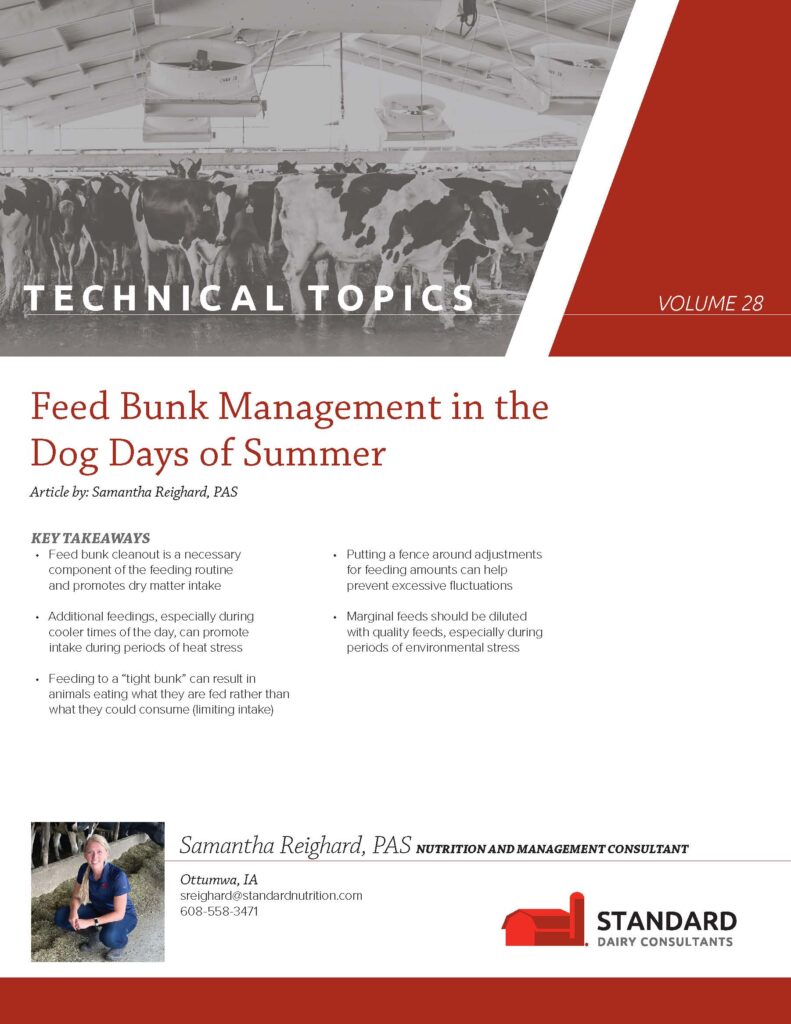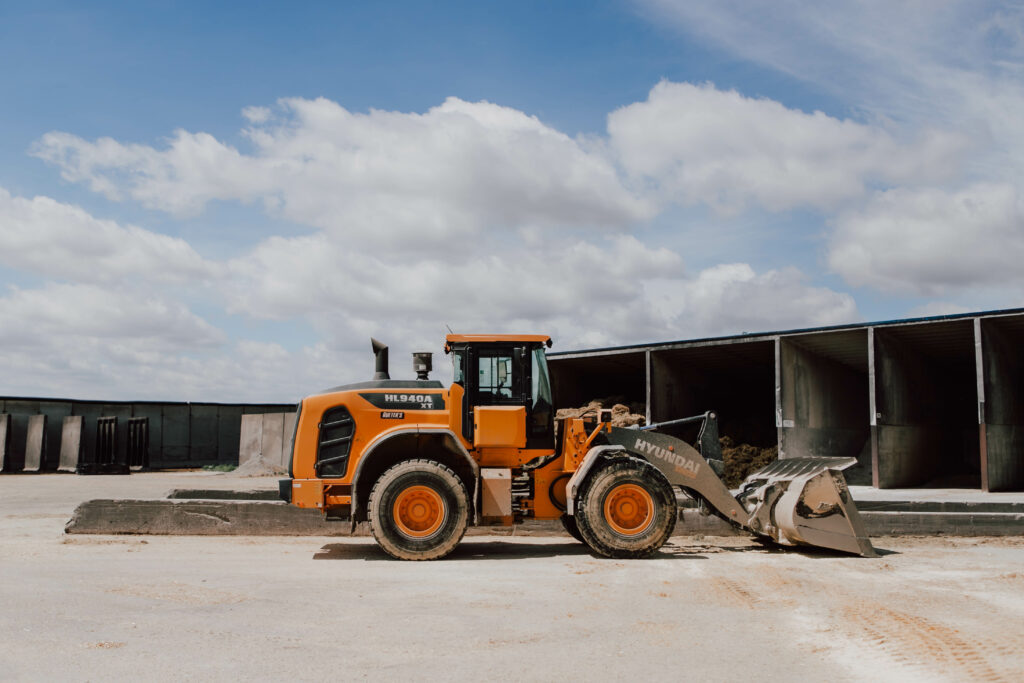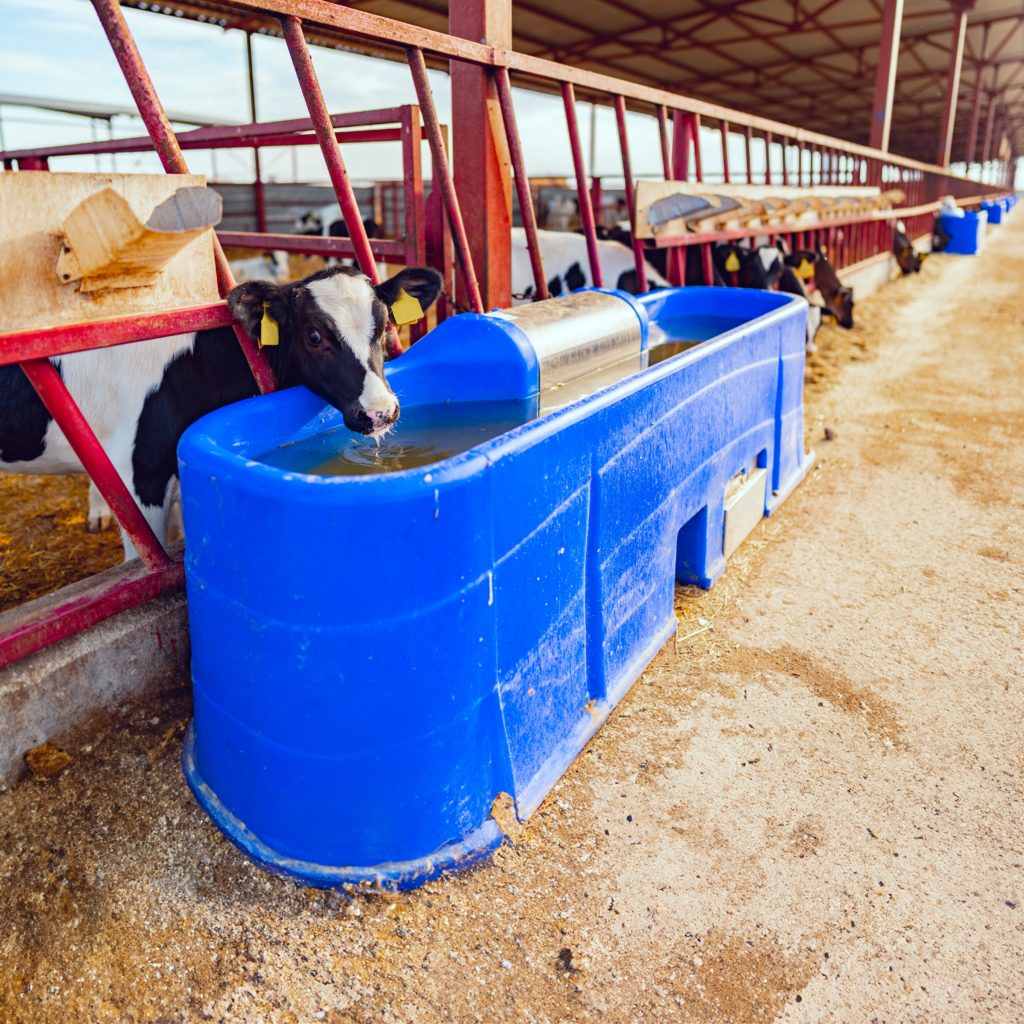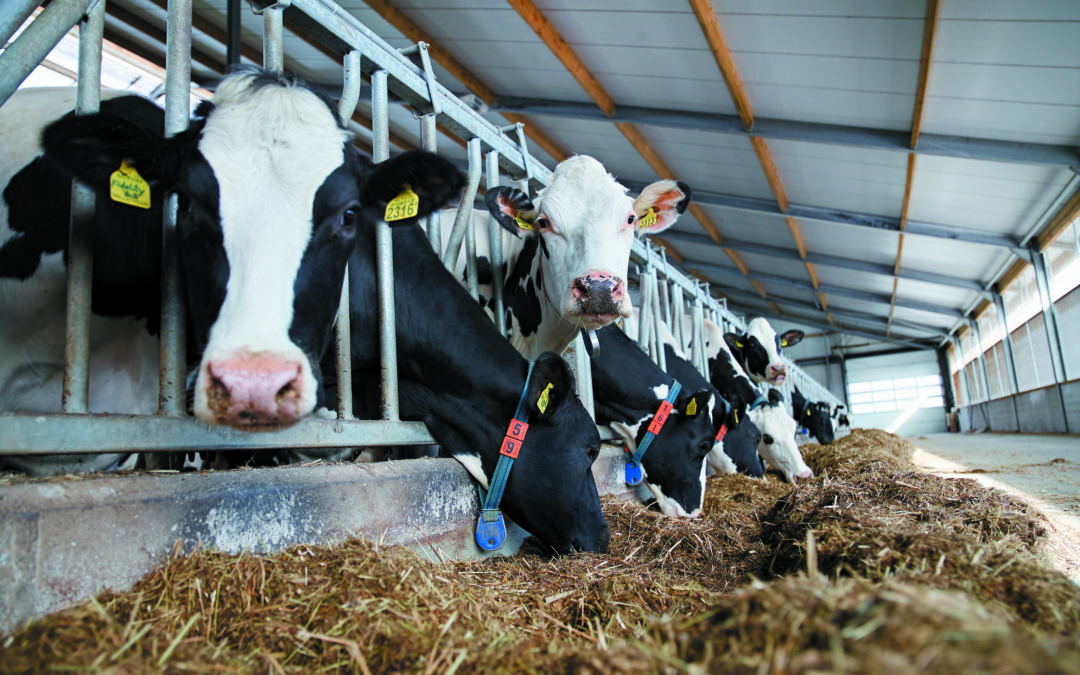Written by: Samantha Reighard, PAS
KEY TAKEAWAYS IN THIS ISSUE OF TECHNICAL TOPICS:
- Feed bunk cleanout is a necessary component of the feeding routine and promotes dry matter intake
- Additional feedings, especially during cooler times of the day, can promote intake during periods of heat stress
- Feeding to a “tight bunk” can result in animals eating what they are fed rather than what they could consume (limiting intake)
- Putting a fence around adjustments for feeding amounts can help prevent excessive fluctuations
- Marginal feeds should be diluted with quality feeds, especially during periods of environmental stress

Managing feed bunks is an everyday process on dairies. The key component is to keep fresh feed available to the cows at the times that they desire to eat. Any break from this strategy will negatively impact productivity from a broad range of perspectives. These negative impacts will include reduced dry matter intake, decreased lying time, more stress on feet and legs due to reduced lying time, and disruption in routine which is critical to the life of a cow. These are detrimental to profits at any time, but become even more pronounced during heat stress.
In a perfect world, feed bunks should be cleaned daily. If bunks aren’t cleaned every day, they should at least be routinely evaluated for cleanliness and cleaned as often as needed. Daily cleanout offers more cleanliness, offers more routine to the day (with less judgement calls for cleaning), and will offer more benefits to the cows. Cows reward the daily cleanout with more consistent dry matter intake and production. TMR management applies to pre-fresh and dry cows as well as lactating animals.
The road to an improperly managed feed bunk is one paved with good intentions. When cleaning, a small amount of feed is left in harder-to-clean areas of the bunk that is ‘not worth’ the effort to remove it. As the feed begins to heat and deteriorate, cows will avoid eating near this spoiling feed. As new feed is continually added to the bunk, the spoilage is hidden and increasing in amount.
Now add a bunk line soaker to cool the cows during heat stress. With the additional moisture, accelerates spoilage in the bunk. The addition of water will initially have very minute effects on the ration. However, in a matter of hours, the ration will heat from oxidation. As the diet heats, the cows are less inclined to eat from this part of the feed bunk. As the cows avoid areas of the bunk, the small corner of feed spoilage can grow into a large portion of the feed quickly. If not cleaning the bunk regularly and thoroughly, new feed is added on top and continues to mask spoilage. It is difficult to find issues like spoilage when we are not focusing on good bunk management. A quick swipe with a foot or hand (preferably with a glove) will expose this spoiled feed if it is present.
Scraping or throwing out feed bunks should not be taken lightly. It is one management practice that when it is done, it must be done carefully and completely. As discussed, leaving material behind is not acceptable and can lead to further problems like decreased production. Why expend the effort and cost of labor and/or fuel if it is not going to give the best possible results? Spoilage prevention is worth the time and cost when considering the costs spoilage can have on the herd.
Why does this matter? The spoiled feed reduces the cow’s desire to eat the diet. During heat stress, cows are less inclined to eat, naturally. Leaving spoiling feed in the feed bunk will exacerbate this issue at a time when the goal is to do anything possible to encourage intake. Heat stress events also lead to producers adding treatments to the ration to potentially extend the life in the bunk. However, one of the best treatments is to put the fresh ration in a clean bunk.
Another consideration to encourage intake in animals is to feed more frequently during the day. The delivery of feed from the truck or trailer has the stimulatory effect of drawing cows to bunk to eat. A more frequent pushup of rations once delivered to the feed bunk will also encourage eating. Fresh feed fed more frequently is the correct recipe for success.

During heat stress, fresh feed delivery becomes even more critical. The fresher the diet, the more inclined cows will be to eat. Feeding a larger proportion of the diet during the cooler times of the day, evenings and early mornings, is also an important consideration. This can create a change of routine for the feeding crew, which can be disruptive. There will be less ‘guessing’ what the cows will eat and more accurate feeding amounts can be delivered. Splitting feed deliveries between the cool portions of the day can lead to potentially smaller amounts of feed refusals to handle the next day. With fresh feed available during crucial cool times of the day, cows will be encouraged to eat as much as possible. Changing human routines is not an easy request at any time, but seeing the benefits of these actions should be encouraging for both the cows and humans.
When feeding to a tight bunk with minimal refusals, there can be a tendency to underfeed cows. This gets dramatically exaggerated during heat stress. As a result, the animals eat what they are fed rather than what they could consume, which limits production. This is truly a tightrope to walk as you don’t want to feed too much or too little to the cows. One consideration is that if cows are constantly fluctuating in intake, the control on what is being fed likely is too limiting. It is important to allow the cows to determine what will be eaten.
What cows are fed and how much cows are fed is vitally important for the dairy operation. When intakes fluctuate, a critical consideration is to limit the change in the amount fed, whether increase or decrease in small incremental steps. Changes in the feeding amount should be limited to 1.0-1.5% of dry matter fed per day as this will help to smooth out some of this fluctuation. There are times when drastic weather changes result in dramatic changes in dry matter intake. These adjustments should be the exception and not allowed to become the rule. Getting the herd back on an even plain of intake as quickly as possible must be the goal. Determining feed amounts should be a team effort and discussed on a regular basis.
The goal is always to feed the best feeds possible to the herd. Feeding the most digestible ration will result in the best production and efficiency. There are times when inventories of less desirable feeds, often forages, must be fed. Blending this marginal material with the best quality feeds is ideal. Dilution is key and having a strategy for this dilution will be the best plan.
During heat stress, the very best of all feeds should be targeted to the herd. Digestion is a heat-producing activity in the cow. Feeding a highly digestible diet encourages intake and minimizes heat production during digestion. Marginal feeds fed to cows during a time when they are less inclined to eat will certainly result in a reduction in production. When possible, the more marginal feeds should be fed during times of the year when intakes are stronger and more consistent and bunk stability is less of an issue. Because these feeds need fed, judgment in when to feed them is essential.
Producers cannot control the weather. The weather affects the feeds that are produced and environment of the facilities where the cows are maintained. However, producers can control how, when, and where the diets are provided to the cows. To the extent possible, the producers can control the quality of the forages fed, the amounts of diet offered, and the timing of the delivery of the diet to a clean bunk. Controlling as many of the variables of any operation as possible is anyone’s desire.
TIPS FOR TRANSPORTATION OF PREWEANING CALVES
Written by: Dan Illg, PhD, PAS
It is well established that water is a critical component for life. Ensuring sufficient and clean water is available to dairy cattle is vital for the success of a dairy. Milk is 87% water. Water makes up approximately 70% of the total body weight of a cow. Water is necessary for virtually all physiological processes including respiration, digestion, cellular function, and heat dissipation. One of the most important factors in the performance of dairy cattle is the quality and quantity of water that is available to these animals. Water testing can be done at most laboratories and should be periodically performed to confirm the consistency of the quality of the water supplied to the herd. Any limits in water intake due to cleanliness, quality, or availability can dramatically reduce the productivity of dairy cattle. As water intake is reduced, dry matter intake will decrease proportionally. As dry matter intake is the driver of all things related to production the relationship between water intake and dry matter intake cannot be ignored.
The amount of water dairy cattle need to be productive is influenced by ration moisture, milk production, environmental temperature, and body weight of the animal, to identify a few of the components. A cow producing 85 lb of milk will consume between 25 – 35 gallons of water. As temperatures increase above thermal neutral, the water requirement increases by ½ gallon for every 2-degree increase. How to determine the amount of water cattle are consuming is not an easy task. Water meters can be placed on water sources, which can give total water available estimate. Certain animal tracking devices attempt to determine drinking activity by measuring swallowing or temperature changes. These measures still do not determine the quantity consumed. Another means to determine water intake is the estimate that 4 pounds of water consumed per pound of DMI. This is a chicken or egg determination. Which influences which?
The least that can be done to support the water needs of dairy cattle is to ensure that water is always available in consumable quantities. Waterers close to the entrance to the pen can be a good indication of adequacy.

If cattle are draining the waterer and standing waiting for water, this is limiting water intake. A larger waterer or an additional waterer would be an appropriate move. The thought that the cow can move on to another waterer has the risk of the cow choosing to do something else. It is important not to complicate her life. A water source available on the parlor exit can also be a plus for these animals as long as it does not impede cow flow.
Water quantity is one issue. Equally important is water cleanliness. Water should never appear colored or murky. Algae mats should not fully cover the surface or waterer walls. There should be no noticeable odors, particularly those of sewage, rotten eggs, mold, or animal waste. These conditions are indicators of dirty water and need cleaning. Merely observing that cows are drinking water, regardless of condition, does not indicate that cows would drink considerably more if the water was clean. When out for a walk, there is a temptation to drink water out of a stream but we do not because of the consequences of doing so. Cows do not have this choice in their pen. They will drink water even if they do not enjoy it, to a point.
Cleaning waterers starts with a commitment to routinely keep the waterers clean. Posting a schedule with a checklist where the responsible person signs off on the activity can be a good way to ensure this is done. Even when it is not scheduled, if a waterer is determined to be contaminated, it should be cleaned.
TO CLEAN THE WATERERS;
- Rinse the waterer twice more with clean
- Empty the waterer completely and remove all debris.
- Rinse the waterer twice with a 10% bleach solution (1 part bleach to 9 parts water).
- Let the bleach solution contact the waterer surfaces for 15 minutes.
There is some hesitation to drain and clean large waterers or troughs due to the amount of water that will be ‘wasted’. The amount of water consumption and production lost due to contaminated waterers is likely multiples of water ‘wasted’ during cleaning. If there is concern about ‘wasted’ water, an alternative is to change the waterer to a type that is easier to clean and therefore keep clean.
Keeping the waterers clean is essential for maintaining water palatability and intake, reducing disease and pathogen risk, and contributing to the overall performance of dairy cattle. Cleaning and disinfecting waterers will help maintain safe water sources for cattle regardless of any particular system design. Water testing and monitoring for potential contaminants at the water source is recommended.


